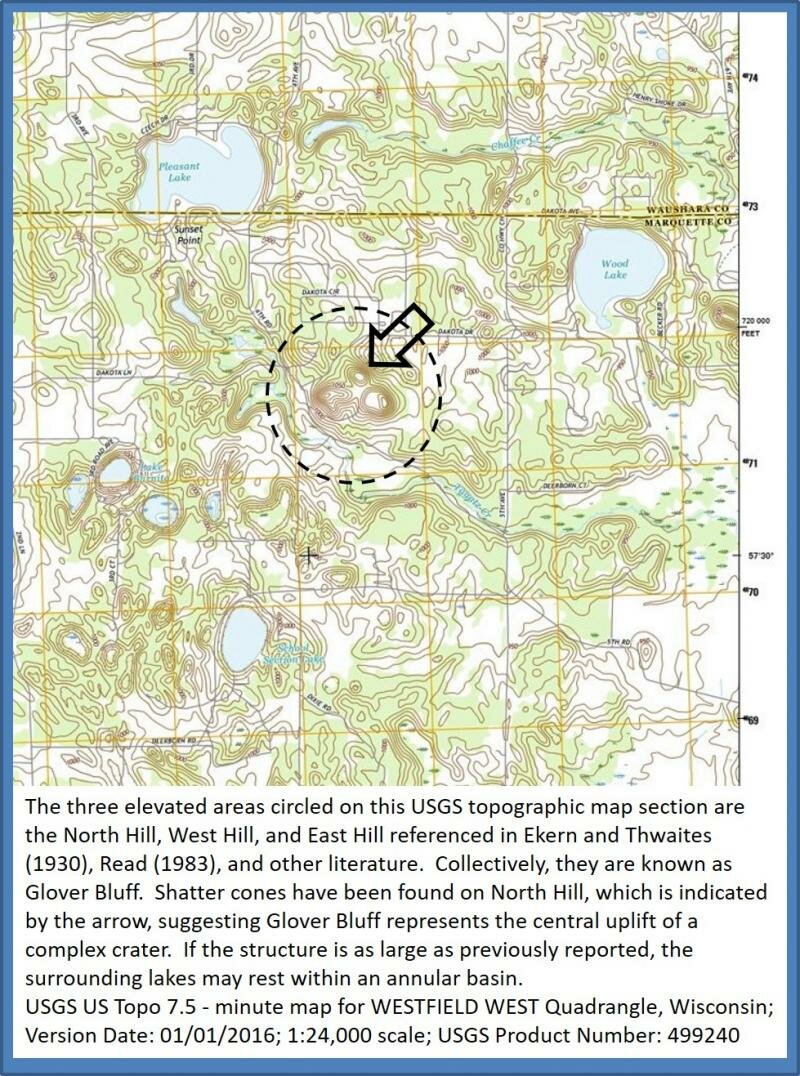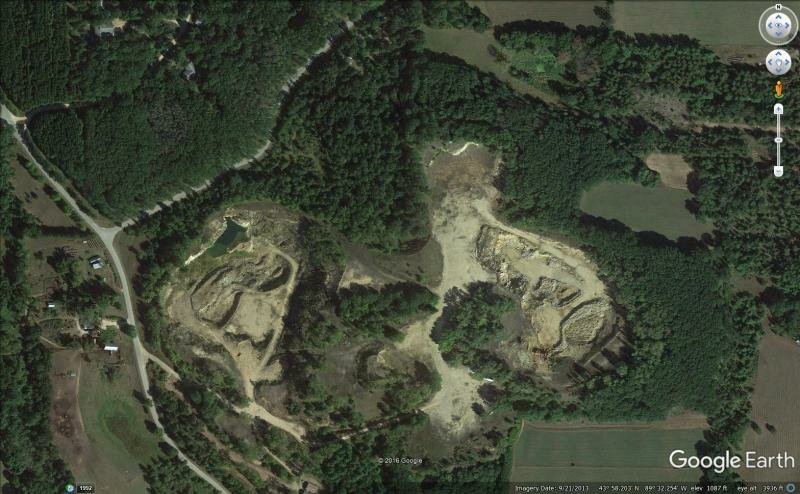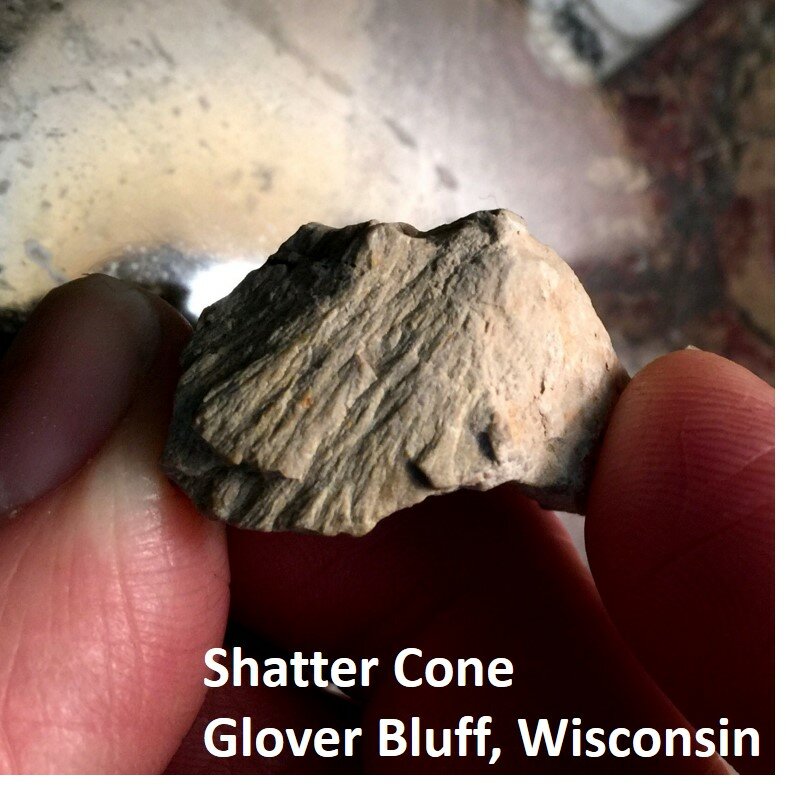United States Meteorite Impact Craters
- Home
- Crater Identification
- Alamo, Nevada
- Ames, Oklahoma
- Avak, Alaska
- Barringer, Arizona
- Beaverhead, Montana
- Chesapeake Bay, Virginia
- Cloud Creek, Wyoming
- Crooked Creek, Missouri
- Decaturville, Missouri
- Decorah, Iowa
- Des Plaines, Illinois
- Flynn Creek, Tennessee
- Glasford, Illinois
- Glover Bluff, Wisconsin
- Haviland, Kansas
- Kentland, Indiana
- Manson, Iowa
- Marquez, Texas
- Middlesboro, Kentucky
- Newporte, North Dakota
- Odessa, Texas
- Red Wing, North Dakota
- Rock Elm, Wisconsin
- Santa Fe, New Mexico
- Serpent Mound, Ohio
- Sierra Madera, Texas
- Upheaval Dome, Utah
- Weaubleau, Missouri
- Wells Creek, Tennessee
- Wetumpka, Alabama
- Possible Impacts
- User-submitted Possibles
- Open Questions
- About This Website
Glover Bluff crater, Wisconsin

Glover Bluff impact crater is a partially exposed and significantly eroded impact structure, about 8 km in diameter, centered in northwest Marquette County and extending into southwest Waushara County, in Wisconsin.
The impact site is preserved in Ordovician and Cambrian dolostone and sandstone (Ekern and Thwaites, 1930). The site was first observed by W. C. Alden, in 1918. The first attempt to describe it structurally in any significant detail was by Ekern and Thwaites, in a brief article published in 1930. The crater is located about 10 km NNW of the town of Westfield, Wisconsin. There is some ambiguity in the literature concerning diameter. Read (1984, 1985) says about 10 km. Dietz and McHone (1991) lists 8 km. Grieve (1987) lists 6 km. A thesis by Koenen (1956) mapped localized gravity and magnetic anomalies associated with the center of the structure. Impact origin was positively confirmed in Read (1983), with a photograph and descriptions of shatter cones.
Age: Read (1985) observes that the impact is contemporaneous with or postdates the Lower Ordovician strata in which it is preserved (beginning about 485 million years ago). He tentatively observes glass-bearing possible ejecta in the middle Ordovician St. Peter sandstone in the nearby region (around 460 to 470 millon years ago). Earnst and Paulsen (2011) compare changes in calcite grains within the crater to those that resulted regionally from the Late Paleozoic Alleghenian orogeny, and conclude that the impact likely pre-dates the mountain building episode (ending about 260 million years ago). This provides a very tentative constraint on the age of the structure, suggesting it occurred between about 485 and 260 million years ago.

The Glover Bluff impact structure is substantially under-researched, compared to most other exposed US impact craters. It needs to be studied and mapped in significantly greater detail and earlier observations need to be refined and contextualized in terms of the modern literature. Despite the fact that this is an exposed impact crater with a series of quarries providing a rare convenient glimpse into the subsurface, the location, target rock units, and even dimensions of the impact structure are only minimally constrained in the published literature. This location provides an untapped research opportunity, and the quarries provide a potentially significant advantage to researchers!

The above image shows West Hill, East Hill and North Hill of Glover Bluff in 2013. Quarrying has been going on in the crater for nearly 100 years (Ekern and Thwaites, 1930). Mindat shows one quarry ( ) in operation in 2015, and provides several nice images from the site. The excavation appears to be operating in presumably uplifted dolostone on the shatter cone bearing peaks of the central uplift and in flanking or overlying megabreccia (inferred, unconfirmed). For an impact crater of this scale, it would be unusual to find shatter cones in the rim.
See also, photos of the site on Charle's Odale's web page:
Evidence of Impact Origin
The impact origin of each location listed on this website has been supported by unambiguous diagnostic evidence of hypervelocity impact that has been reported in a scientific (usually peer reviewed) context. Without such evidence, a geological structure is not a confirmed impact crater. This section, which is included for each crater on this website, is not an exhaustive list of such published evidence, but is meant to demonstrate that appropriate work has been done for each listing.
- shatter cones
Other significant evidence: breccia, megabreccia, morphology (only sparsely mapped).

This site has also been published as: Glover Bluff Structure, Glover Bluff Disturbance
Bibliography and References:
(If links to articles don't work, don't give up. Try pasting the link shown into a search engine or searching for the article authors, title, or other reference information. If your research leads you to additional scientific references related to this crater, please help improve this resource by sending a note with the new citation(s) to: )
Alden W. C. 1918. Quaternary geology of southeastern Wisconsin. U. S. Geological Survey Professional Paper 106, pages 207-208.
Cannon, W. F., Mudrey, M. G. Jr. 1981. The potential for diamond-bearing kimberlite in Northern Michigan and Wisconsin. U.S. Geological Survey Circular 842, 15 pages.
Coleman, L. D. 2001. A Meteorite Crater in the Backyard. Meteorite magazine, Volume 7, Feb. 2001. pages 8-11.
no link found
Dietz, R. S. & McHone, J. F. 1984. Shatter Cones: Difinitive Criteria for Meteorite Impact. Meteoritics, Volume 19, page 221.
Dietz, R. S., McHone, J. F. 1991. Astroblemes recently confirmed with shatter cones (abstract). Meteoritics, Volume 26, page 332.
Ekern, G. L., Thwaites, F. 1930. The Glover Bluff structure, a disturbed area in the Paleozoics of Wisconsin. Transactions of the Wisconsin Academy of Sciences, Arts and Letters, Volume 25, pages 89-97.
Ernst B. and Paulsen T. 2011. New constraints on the timing of deformation at the Glover Bluff structure near Coloma, WI, from a calcite twinning analysis (abstract). Abstracts with Programs - Geological Society of America, Volume 43. No 5. page 188.
https://gsa.confex.com/gsa/2011AM/finalprogram/abstract_194868.htm
Grieve R. A. F. 1987. Terrestrial Impact Structures. Annual Review Earth Planetary Science, Volume 15 pages 245-270.
Koenen, K. H. 1956. Geophysical studies in south central Wisconsin. Unpublished Master's Thesis, University of Wisconsin, Madison, 44 pages.
Read, W. F. 1983. Shatter cones at Glover Bluff, Wisconsin. Meteoritics, Volume 18, No. 3, pages 241-243.
Read, W. F. 1984. The circular structure at Glover Bluff: What and where it is (abstract). Meteoritics, Volume 19, pages 295-296.
Read, W. F. 1985. Impact bombs in Middle Ordovician marine sediments of southeastern Wisconsin (abstract). Abstracts of the 16th Lunar and Planetary Science Conference. pages 687-688.
Renard G. M. 2011 Ejecta strata of recent origin have been identified in central Wisconsin at Glover Bluff impact site (abstract). Geological Society of America - Abstracts with Programs. Vol. 43, No. 5, p.306
.
Copyright 2011, 2012, 2013, 2014, 2015, 2016 United States Meteorite Impact Craters. All rights reserved.